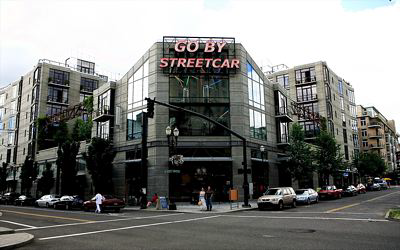No Light Rail in Vancouver!
Light rail costs too much, does too little
Transit Industry Skillfully Manipulates Media
About 100 mixed-use, transit-oriented developments are being built in this country,
says the June 11 Wall Street Journal (link will expire in six days). The writer of
the article falls for the transit propaganda about “revitalizing cities” and “smaller
households” wanting to live in higher densities.
Most mixed-use developments “are public-private partnerships,” admits the article.
“Local governments build or refurbish rail lines and surrounding infrastructure like
roads and parking facilities. Private developers then build in the surrounding areas.”
This just shows how the transit industry has appropriated the term “public-private
partnership” for its own ends. The highway industry uses that term to mean, essentially,
franchises in which a contractor makes an investment in a new or existing road and
is allowed to recoup that investment through tolls. Highway public-private partnerships
cost taxpayers nothing and can produce enormous benefits.
The transit industry uses the term to mean giving contractors huge subsidies, often
to do things for which there is little market demand. Using the same term to mean
something very different successfully confuses reporters and elected officials.
The author of this article, for example, buys into the claim that “if the public
sector puts money into a transit system, they can expect three to five times that
amount in private money for adjacent development.” In fact, Portland found that a
transit system alone produces no adjacent development; instead, you also have to
subsidize the development.
When cities subsidize the development, they call it “revitalization,” but that is
just another buzzword used by the transit industry. In fact, it is likely that developers
would have gladly built in the area anyway; without the subsidy, they just would
not have built a mixed-use development.
Either way, we are talking about subsidies and the implication is that there is some
kind of benefit-cost ratio going on here: spend $1 of public money to get $3 to $5
of private money. But that private money is not a public benefit; it is a cost that
may yield private benefits to the investor. What does the public get? A tax bill
with little or no compensation, especially since the property and sales taxes collected
from the new development are usually funneled back into subsidies for the development.
When Neil Goldschmidt arranged for Bechtel to receive a no-bid contract to build
one of Portland’s light-rail lines, he called it a public-private partnership. Some
of Portland’s elected officials were fooled into believing that Bechel was building
the line at its own expense at no cost to the taxpayers. In fact, the line cost taxpayers
about $125 million (and today, six years after it opened, still carries very few
riders).
Streetcar companies used to get franchises to operate streetcars in cities — they
paid all the cost except for some of the right of way. Nobody called them public-private
partnerships. Today’s transit public-private partnerships are nothing like that.
Advocates of highway public-private partnerships need to come up with a new term
to describe their proposals. I like “franchises.” Then they need to make it absolutely
clear that franchises are unsubsidized while transit public-private partnerships
are heavily subsidized and usually a waste of taxpayers’ money.
Reprinted from The Antiplanner

